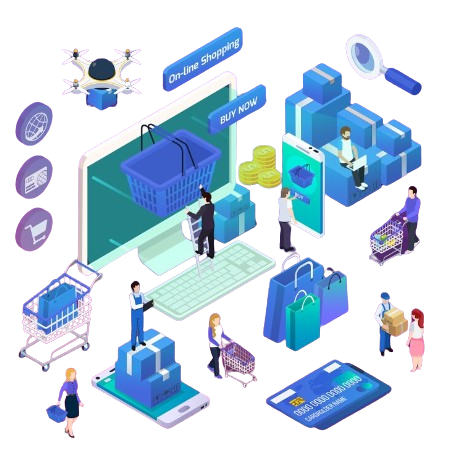Big Data in Retail is revolutionizing the way retailers interact with customers and manage their operations. By harnessing the power of big data, retailers can deliver personalized experiences, optimize their operations, and make data-driven decisions that drive growth and success.
In today’s competitive market, retailers are constantly seeking innovative ways to enhance customer experiences and drive sales. The advent of Big Data in Retail has revolutionized the industry, providing businesses with unprecedented insights into customer behavior and preferences. This blog post explores how Big Data in Retail is transforming the customer experience, the technologies behind it, and the benefits it brings to both retailers and consumers.
The Power of Big Data in Retail
Big Data in Retail refers to the vast amounts of data generated by customers through various channels such as online shopping, social media, and in-store interactions. This data includes everything from purchase history and browsing patterns to social media activity and customer feedback. By harnessing this data, retailers can gain a deeper understanding of their customers, enabling them to deliver personalized experiences, optimize operations, and make data-driven decisions.

Technologies Driving Big Data in Retail
Several cutting-edge technologies are instrumental in leveraging Big Data in Retail. These technologies collect, analyze, and visualize data, turning raw information into actionable insights. Some of the key technologies include:
- Artificial Intelligence (AI): AI algorithms analyze large datasets to identify patterns and trends. Machine learning models can predict customer behavior, recommend products, and optimize pricing strategies.
- Internet of Things (IoT): IoT devices, such as smart shelves and beacons, collect real-time data from physical stores. This data helps retailers track inventory levels, monitor customer movement, and optimize store layouts.
- Cloud Computing: Cloud platforms provide the infrastructure needed to store and process large volumes of data. They offer scalable solutions for data storage, computing power, and analytics.
- Data Analytics Platforms: Tools like Hadoop and Apache Spark enable retailers to process and analyze big data efficiently. These platforms provide real-time analytics and visualization capabilities.
- Customer Relationship Management (CRM) Systems: CRM systems integrate data from various sources, providing a comprehensive view of each customer. This enables personalized marketing and targeted promotions.
Transforming Customer Experiences
Big Data in Retail is transforming customer experiences in several ways:
- Personalized Shopping Experiences: By analyzing customer data, retailers can create personalized shopping experiences. This includes tailored product recommendations, customized marketing messages, and individualized promotions. For example, an online retailer can recommend products based on a customer’s browsing history and previous purchases.
- Optimized Inventory Management: Big Data helps retailers optimize inventory levels by predicting demand and identifying trends. This ensures that popular items are always in stock, reducing the risk of lost sales. Additionally, it minimizes overstocking, which can lead to increased costs.
- Enhanced Customer Service: Data from various touchpoints, such as social media and customer feedback, helps retailers understand customer preferences and pain points. This enables them to provide better customer service and address issues proactively.
- Improved Pricing Strategies: Big Data analytics allows retailers to implement dynamic pricing strategies. By analyzing factors such as demand, competition, and market trends, retailers can adjust prices in real-time to maximize revenue and remain competitive.
- Targeted Marketing Campaigns: Big Data enables retailers to segment their customer base and create targeted marketing campaigns. This increases the effectiveness of marketing efforts and ensures that customers receive relevant offers and promotions.
Benefits of Big Data in Retail
The adoption of Big Data in Retail brings numerous benefits to both retailers and consumers:
- Increased Sales: Personalized experiences and targeted marketing lead to higher conversion rates and increased sales.
- Customer Loyalty: By delivering relevant and personalized experiences, retailers can build stronger relationships with customers, fostering loyalty and repeat business.
- Operational Efficiency: Big Data helps retailers optimize their operations, from inventory management to supply chain logistics. This reduces costs and improves overall efficiency.
- Data-Driven Decision Making: Access to real-time data and analytics enables retailers to make informed decisions, minimizing risks and maximizing opportunities.
- Competitive Advantage: Retailers who leverage Big Data gain a competitive edge by staying ahead of market trends and understanding customer needs better than their competitors.
Conclusion
Big Data in Retail is revolutionizing the way retailers interact with customers and manage their operations. By harnessing the power of big data, retailers can deliver personalized experiences, optimize their operations, and make data-driven decisions that drive growth and success.
Tanbits offers big data services that help retailers harness the power of big data to transform their customer experiences and operations.
Embracing Big Data in Retail is no longer optional; it’s a necessity for staying competitive in today’s fast-paced market. The future of retail lies in the ability to leverage data to create meaningful and personalized customer experiences.
BACK










